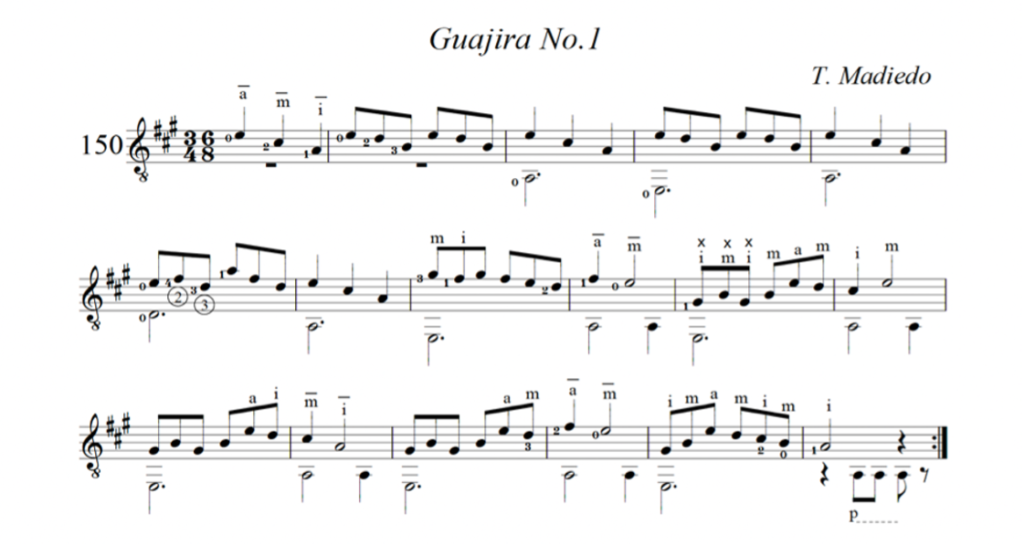Cuban Music in the Method
I would like to discuss a piece from the method named Guajira No. 1 by Teresa Madiedo. Madiedo is a Cuban guitarist, professor, and composer. She has performed in major guitar festivals in Cuba, Mexico, Costa Rica, Algeria, Ecuador, and the US. From 1972-1985 she performed in the guitar duo Madiedo Perez Puentes. As a composer, she has a varied output with guitar studies, four guitar works, guitar solos, and duo pieces.
She taught at the Conservatory Manuel Saumell and Adolfo Guzman and then at Escuela Nacional de Música ENA in Cuba for several years. She also has been a professor at Universidad del Cauca Popayan in Colombia and the Conservatory at Tijuana Baja California, Mexico. After settling in the US, she worked at Miami Dade College North campus. She created an innovative method for teaching elementary guitar based on the association of colored notes to colored strings called the Madiedo Method.[1]
Guajira No. 1 is included in Unit IV of the first book. The piece is based on a popular genre called guajira, a Cuban narrative song form derived from the rural folk tradition. This genre, part of the canción cubana complex, was still prevalent in rural and urban areas at the end of the 20th-century. One of its main features is the alternation of 3/4 and 6/8 meters.[2]This mixture is reflected in the time signatures and how the rhythmic figures are accommodated in each measure. The characteristic rhythm stays throughout with little variations. (See Example 1) This piece’s rhythms help the student to work on these two meters, their proportion, and metrical accents from an early stage of the learning process.

Example 1 Teresa Madiedo, Guajira No. 1.
The A major tonality with this tonic-dominant harmony gives the piece a festive and dance-like feeling that balances the repertoire perfectly. Sometimes the methods are filled with exercises that can be tiring and boring for inexperienced students, so this type of music can be desirable for these young learners.
Regarding the technical challenges, Madiedo indicated in the score to make the quarter notes with apoyando (rest stroke). This technique forces the student to alternate rest and free strokes (rest on the 3/4 and free on the 6/8 arpeggios). To do this, the students must combine two different techniques. This approach also helps to highlight the meter change, emphasizing the three notes of the 3/4 measures and the “a” finger on the 6/8 that coincides with the first note of the subdivisions.
[1] Teresa Madiedo. “Biography.” https://www.teresamadiedo.com/#Bio accessed March 13, 2023.
[2] William Gradante, “Guajira,” Grove Music online, 2021; Accessed March 12, 2023. https://www.oxfordmusiconline.com/grovemusic/display/10.1093/gmo/9781561592630.001.0001/omo-9781561592630-e-0000011889?rskey=GhidJL&result=1